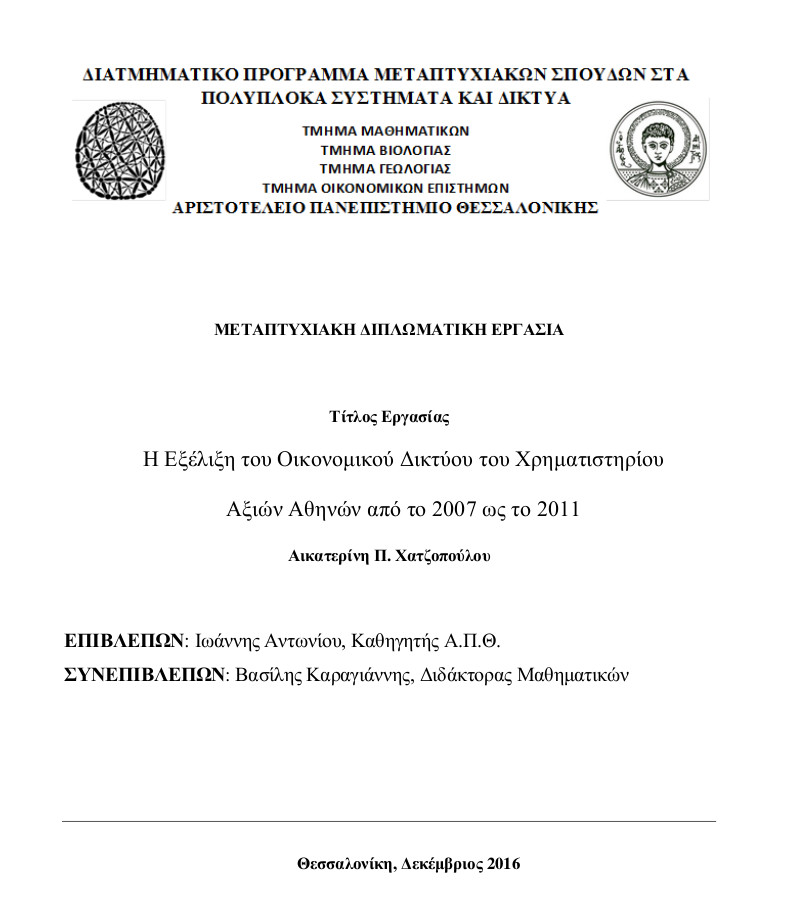
Exploration of trade structures of rice and wood sectors. Case study on agricultural - forest trade networks and intra industry trade
Περίληψη
The aim of the present thesis is the exploration of trade structures of rice and wood sectors. Social Network Analysis is used for investigation of agricultural and forest trade networks. Main goal of this study is to analyze international agricultural market, applying network theory. Particularly, centrality measures will be used. The countries will be ranked in hierarchies of import-export relations and these hierarchies will be visualized. Networks are dynamically described within and between 2011 and 2015 years. The benefit that is received from representing the inter country trade as a network of either trade partnerships or trade flows is the possibility to depict the interaction between trading countries and their hierarchies which otherwise remain indiscernible. Moreover, another advantage from network analysis is the detection of possible correlations between the hierarchical position of the countries inferred from network variables and their non-network characteristics resulting from conventional economic indicators. Each network is examined in weighted form, taking into consideration the economic value of trade flows and unweighted form that considers only the bilateral trade partnerships.
Πλήρες Κείμενο:
PDFΑναφορές
Bauer F. & Lizier J. T. (2012). Identifying influential spreaders and efficiently estimating infection numbers in epidemic models: A walk counting approach. Europhys
Lett 99, 68007
Baur, M. (2008). Visone-Software for the Analysis and Visualization of Social Networks, Karlsruhe, Univ., Diss., 2008
Borgatti, S. (2005). Centrality and Network Flow. Social Networks. Elsevier. 27: 55–71.
Brin, S. and Page, L. (1998). The Anatomy of a Large-Scale Hypertextual Web Search Engine. Computer Networks and ISDN Systems, 30(1-7):107-117, 1998.
Da Silva R. A. P., Viana M. P. & da Fontoura Costa L. (2012). Predicting epidemic outbreak from individual features of the spreaders. J Stat Mech Theor Exp2012, P07005
De Benedictis, L., Tajoli, L. (2010). Comparing Sectoral International Trade Networks. Aussenwirtschaft Vol. 65 Iss. 2
De Benedictis, L, Nenci, S, Santoni, G, Tajoli, L, Vicarelli, C. (2013). Network Analysis of World Trade using the BACI-CEPII dataset, Centre D’ etude Prospectives et D’informations internationals.
Deguchi T, Takahashi K, Takayasu H, Takayasu M (2014). Hubs and Authorities in the World Trade Network Using a Weighted HITS Algorithm. PLoS ONE 9(7): e100338. doi:10.1371/journal.pone.0100338
Fagiolo, G., Reyes, J., & Schiavo, S. (2009). The evolution of the world trade web: a weighted-network analysis. Journal of Evolutionary Economics, 20(4), 479–514.
Garlaschelli, D., & Loffredo, M. I. (2005). Structure and evolution of the world trade network. Physica A: Statistical Mechanics and its Applications, 355(1), 138–144.
Grubel, Herbert G.; Lloyd, Peter J. (1971). The Empirical Measurement of Intra-Industry Trade. Economic Record 47 (4): 494–517.
Grubel, Herbert G.; Lloyd, Peter J. (1975). Intra-industry trade: the theory and measurement of international trade in differentiated products. New York: Wiley. ISBN 0-470-33000-7.
Helpman, E., Melitz, M., and Rubinstein, Y. (2008). Estimating Trade Flows: Trading Partners and Trading Volumes. Quarterly Journal of Economics, 123 (2), 441-487.
Helpman E. and Krugman P. (1985). Market structure and foreign trade: increasing returns, imperfect competition and the international economy, Mit Press.
International trade statistics 2001-2015. Available: http://www.intracen.org/itc/market-info-tools/trade-statistics/ . Accessed: 2016 May 18.
Katz, L. (1953). A new status index derived from sociometric analysis. Psychometrika, 18(1):39-43.
Kleinberg, J.M. Authoritative Sources in a Hyperlinked Environment. Journal of the ACM, 46(5):604-632, 1999.
Kleinwechter, U. and Suarez, V. (2013). Really a nontraded commodity? A look at the international potato trade network (dataset and R code). ZENODO. http://dx.doi.org/10.5281/zenodo.7593
Ladias, Ch., Hasanagas, N., Papadopoulou, E. (2011). Conceptualizing ‘macroregions’: Viewpoints and tools beyond NUTS classification, Studies in Agricultural Economics 113(2), 138-144
Lawyer, G. (2015). Understanding the spreading power of all nodes in a network. Scientific Reports. 5 (O8665): 8665.
Raskovic, M, Udovic, B, Znidarsic, A. (2015). Network Analysis of Inter-Country Export Patterns in the EU: Implications for small states. Teorija in Praksa,
Serrano, M., & Bogunα, M. (2003). Topology of the world trade web. Physical Review E, 68(1), 1–4.
Sikic, M., Lancic, A., Antulov-Fantulin, N., Stefancic, H. ( 2013). Epidemic centrality - is there an underestimated epidemic impact of network peripheral nodes?. European Physical Journal B. 86(10): 1–13.
Watts, D.J. and Strogatz, S.H. (1998). Collective Dynamics of Small-World" Networks. Nature, 393:440-442.
World Bank national accounts data, and OECD National Accounts data files. Available: http://data.worldbank.org/indicator/NY.GDP.PCAP.PP.CD. Accessed: 2016 October 10.
World Bank national accounts data, and OECD National Accounts data files. Available: http://data.worldbank.org/indicator/NY.GDP.PCAP.CD. Accessed: 2016 October 10.
Εισερχόμενη Αναφορά
- Δεν υπάρχουν προς το παρόν εισερχόμενες αναφορές.
